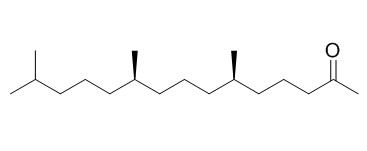Phytone
Phytone appeares to enhance both the sticky materials production and cell growth, suggesting that it plays some role in the increase of sticky materials and cell growth.
Inquire / Order:
manager@chemfaces.com
Technical Inquiries:
service@chemfaces.com
Tel:
+86-27-84237783
Fax:
+86-27-84254680
Address:
1 Building, No. 83, CheCheng Rd., Wuhan Economic and Technological Development Zone, Wuhan, Hubei 430056, PRC
Providing storage is as stated on the product vial and the vial is kept tightly sealed, the product can be stored for up to
24 months(2-8C).
Wherever possible, you should prepare and use solutions on the same day. However, if you need to make up stock solutions in advance, we recommend that you store the solution as aliquots in tightly sealed vials at -20C. Generally, these will be useable for up to two weeks. Before use, and prior to opening the vial we recommend that you allow your product to equilibrate to room temperature for at least 1 hour.
Need more advice on solubility, usage and handling? Please email to: service@chemfaces.com
The packaging of the product may have turned upside down during transportation, resulting in the natural compounds adhering to the neck or cap of the vial. take the vial out of its packaging and gently shake to let the compounds fall to the bottom of the vial. for liquid products, centrifuge at 200-500 RPM to gather the liquid at the bottom of the vial. try to avoid loss or contamination during handling.
Inflammation.2015, 38(4):1502-16
Molecules.2023, 28(7):3039.
Chem Biol Interact.2024, 398:111103.
Proc Biol Sci.2024, 291(2015):20232578.
Phytomedicine.2018, 41:62-66
Foods.2023, 12(7):1355.
Journal of Apiculture2023.38(3):249-254.
Journal of Functional Foods2023, 104:105542
Mol Neurobiol.2021, 58(8):3665-3676.
Vet World.2023, 16(3):618-630.
Related and Featured Products
Nippon Shokuhin Kagaku Kogaku Kaishi, 1997, 44(11):812-5.
Stimulative Effect of Phytone on the Production of Sticky Materials in Bacillus subtilis(natto).[Reference:
WebLink]
The quality of natto depends on the quantity of sticky materials (SM) which are produced by the starter. Bacillus subtilis (natto) strain.
METHODS AND RESULTS:
In this study, we found that Phytone, papain-digested soy protein, significantly enhanced the SM production by B. subtilis (natto). L-Glutamate was also found to exhibit the same effect. When 1% Phytone was added to SG medium, SM was produced 5-10 times more than that in the standard SG medium. Phytone appeared to enhance both the SM production and cell growth, suggesting that it plays some role in the increase of SM and cell growth. L-Glutamate (3-5%), on the other hand, enhanced SM production but not cell growth.
CONCLUSIONS:
We therefore deduced, that the effect of Phytone was different from that of L-glutamate.
J Ethnopharmacol . 2021 Mar 25;268:113676.
Albizia lebbeck and Albizia zygia volatile oils exhibit anti-nociceptive and anti-inflammatory properties in pain models[Pubmed:
33301915]
Abstract
Ethnopharmacological relevance: Albizia lebbeck and Albizia zygia are used in Nigeria, South Africa and other countries for the treatment of flu, fever, pain, epilepsy, and inflammation.
Aim of the study: Application of plant essence for treating ailments is common among local communities. This research was designed to characterize the volatile compounds and evaluate the toxicity, anti-inflammatory and anti-nociceptive properties of this plant species.
Materials and methods: The volatile oils were analysed comprehensively utilizing gas chromatography-flame ionization detector (GC-FID) and gas chromatography coupled with mass spectrometry (GC/MS) using the HP-5 column. The toxicity was evaluated using the toxicity assay. The anti-nociceptive and anti-inflammatory assays were analysed by a hot plate, Formalin, and carrageenan-induced edema assays, respectively.
Results: The essential oils were obtained in a yield of 0.1% (v/w) calculated on a dry weight basis for both oils. The main compounds of A. lebbeck were 2-pentylfuran (16.4%), (E)-geranyl acetone (15.46%), (E)-α-ionone (15.45%) and 3-Octanone (11.61%), while the oil of A. zygia is mainly hexahydrofarnesyl acetone (33.14%), (E)-methyl isoeugenol (11.7%) and 2-methyl tetradecane (6.64%). The volatile oils are non-toxic to about 5000 mg/kg dose. Albizia zygia significantly (P < 0.001) suppressed the nociceptive afferent fibres in a non-dose dependent manner in comparison to A. lebbeck in the hot plate model. Both oils inhibited nociceptive mediators at both phases of the formalin-induced assay, with a maximum inhibition (100%) at the inflammatory stage. The volatile oils inhibited the Carrageenan-induced inflammation at all phases ranging from P < 0.05 to P < 0.001. The probable pro-inflammatory inhibitory mechanism might be the suppression of some pain biomarkers such as histamine, serotonin, bradykinin, and the Interleukins (ILs) induced by the edema. Volatile constituents such as ionones, eugenol derivatives and other compounds cause the anti-nociceptive and anti-inflammatory activities reported.
Conclusion: This is the first report of the volatile oils and bioassays of Albizia zygia, while the study also confirms previous studies of A. lebbeck. Generally, the findings further prove the use of the plants as pain ameliorating agents.
Keywords: (E)-geranyl acetone; (E)-methyl isoeugenol; 2-Pentyl furan; 3-Octanone; Albizia lebbeck; Albizia zygia; Anti-nociceptive; Hexahydrofarnesyl acetone; Mediators; Volatile oils; α-ionone.



